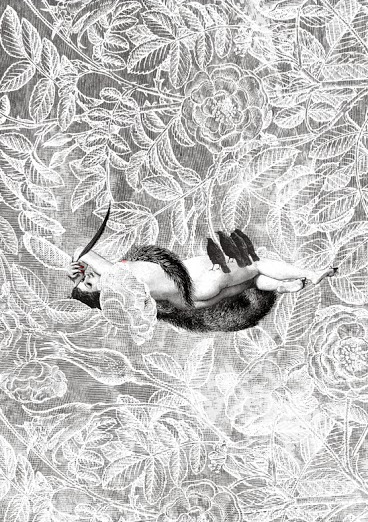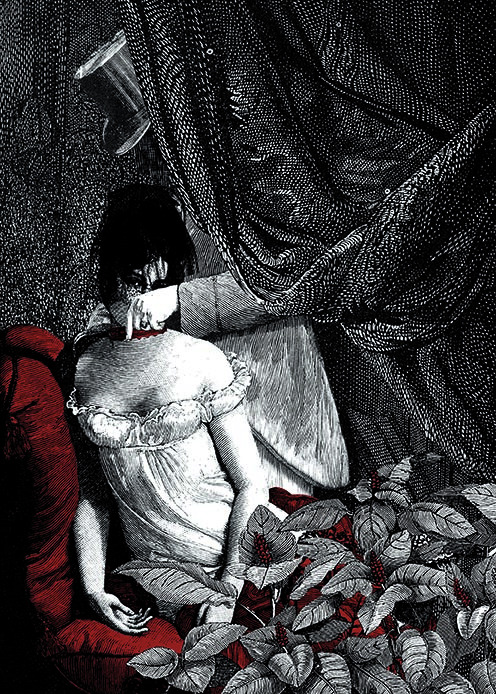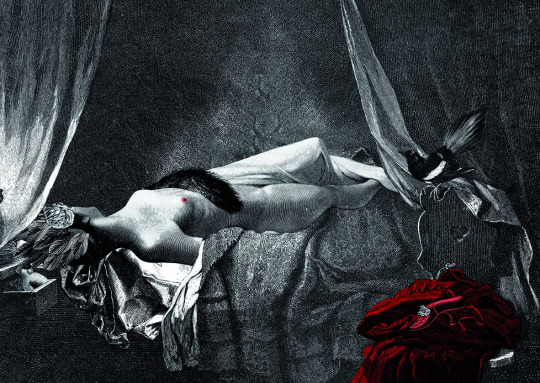"There really is no such thing as art. There are only artists." ~ Gombrich dixit
Don't wanna be here? Send us removal request.
Photo








The Bloody Chamber and Other Stories, by Angela Carter
Illustrated by Igor Karash (The Folio Society)
Igor Karash won the second House of Illustration/Folio Society Illustration Award for his work on Angela Carter’s seminal retellings of fairy tales.
5K notes
·
View notes
Photo








Angela Carter’s The Bloody Chamber and Other Stories (Spanish edition: “La cámara sangrienta” · Publisher: Sexto Piso, 2014)
Collage illustrations by Alejandra Acosta.
2K notes
·
View notes
Photo



SAINTS & FASHION
Bernardino de Villegas, Jesuit priest, against the Baroque depiction of virgin martyrs and saints in the arts - 1625 text (vs.) Francisco de Zurbarán's series of paintings of female saints:
"Is there anything more indecent than those virginal saints dressed in such profane attire, with so many pendants and such finery, that not even the wealthiest ladies wear? Sometimes, even a man might doubt whether to worship them as St. Lucy, or St. Catherine, or to glance away to avoid seeing the profanity of their garments, given that with their dresses and ornaments they do not seem heavenly saints, but earthly ladies. St. Catherine is not shown sword in hand, nor St. Lucy with her eyes on a plate, so nobody would say they could be saints, nor the most honest virgins, according to their gowns and garments in which they have been dressed."
Original text: “¿Qué cosa más indecente que (…) unas santas vírgenes vestidas tan profanamente, y con tantos dijes y galas, que no traen mas las damas más bizarras del mundo? Que a veces duda un hombre, si las adorará por santa Lucía, o santa Catalina, o si apartará los ojos por no ver la profanidad de sus trajes: porque en sus vestidos y adornos no parecen santas del cielo, sino damas del mundo. Y a no estar santa Catalina con sus espada en la mano, y santa Lucía con sus ojos en el plato, por lo que toca al vestido y traje galán con que las visten, nadie dijera que eran santas, ni vírgenes honestísimas, como lo fueron.”
(Source: Bernardino de Villegas, "La esposa de Christo: Instruida con la vida de Santa Lutgarda virgen, Monja de S. Bernardo" (1625). Libro Quarto - Cap. XVIII - p. 530)
155 notes
·
View notes
Photo


Gustav Klimt and Emilie Flöge on Lake Attersee, 1913
Photographer: Friedrich G. Walker (Autochrome Lumière Plate)
* Only color photograph of Gustav Klimt that has been passed down to us.
666 notes
·
View notes
Photo










EL GRECO · In Search of Abstraction
Photographs by Bernardo Pérez ("El Greco de cerca")
#el greco#painting#detail#art detail#art history#16th century#17th century#mannerism#mannerist art#mannerist painting#renaissance#renassaince art#renassaince painting#spanish art#spanish painting#history#spain#colour#color#art
818 notes
·
View notes
Photo

Thisbe, c. 1900
Detroit Publishing Co., Library of Congress
220 notes
·
View notes
Photo


1. “Amorita”, [Model, flowers in hair, head tilted], c. 1900
2. [Model, flowers in hair, head level]
Detroit Publishing Co. , Library of Congress (1 - 2)
153 notes
·
View notes
Photo


TITANIA, Queen of the Fairies
Illustrations by William Heath Robinson, from "Shakespeare’s Comedy of A Midsummer-Night’s Dream" (New York, Henry Holt and Company, 1914)
Coloured Plates: ”Titania. [Act IV.]" & "Titania. Be kind and courteous to this gentleman. [Act III. Sc.1.]”
(Read online)
152 notes
·
View notes
Photo




Henri de Toulouse-Lautrec, ‘The Sacred Grove’, 1884
Toulouse-Lautrec created this work while studying under the painter Fernand Cormon. The painting parodies Pierre Puvis de Chavannes’s “The Sacred Grove Cherised by the Arts and Muses," which was awarded the grand prize at the 1884 Paris Salon.
Lautrec effectively mimics the style and subject matter of the original but makes significant alterations. Notice the clock on the antique portico and the kneeling adolescent in the corner, eating a loaf of bread. The most irreverent anachronism, however, is the group of men disruptively parading into Puvis’s harmonious forest. They include fellow artists, acquaintances, and Lautrec himself, who stands with his back to the viewer - urinating on the ground. (via pearlmancollection)
59 notes
·
View notes
Photo

Marjorie Cameron, Holy Guardian Angel according to Aleister Crowley, 1966. Casein and gold lacquer on board
(Courtesy of the Cameron Parsons Foundation, Santa Monica. Photo Credit: Alan Shaffer)
397 notes
·
View notes
Photo


Marjorie Cameron, East Angel · West Angel, n.d., Graphite, ink and gold paint on paper
(Courtesy of the Cameron Parsons Foundation, Santa Monica. Photo Credit: Alan Shaffer)
873 notes
·
View notes
Photo

Happy Birthday Andy!
Andrew Warhola, Jr. at Age 8, 1936 [+]
74 notes
·
View notes
Photo
by Dennis Hopper

101 notes
·
View notes
Photo

Épigraphe pour un livre condamné
Lecteur paisible et bucolique, Sobre et naïf homme de bien, Jette ce livre saturnien, Orgiaque et mélancolique. Si tu n’as fait ta rhétorique Chez Satan, le rusé doyen, Jette! tu n’y comprendrais rien, Ou tu me croirais hystérique. Mais si, sans se laisser charmer, Ton oeil sait plonger dans les gouffres, Lis-moi, pour apprendre à m’aimer; Ame curieuse qui souffres Et vas cherchant ton paradis, Plains-moi!… sinon, je te maudis!
— Charles Baudelaire · "Nouvelles fleurs du mal" (1861)
* * *
Epigraph for a Condemned Book
Quiet and bucolic reader, Upright man, sober and naive, Throw away this book, saturnine, Orgiac and melancholy.
If you did not do your rhetoric With Satan, that artful dean, Throw it away, you’d grasp nothing, Or else think me hysterical.
But if, without being entranced, Your eye can plunge in the abyss, Read me, to learn to love me;
Inquisitive soul that suffers And keeps on seeking paradise, Pity me!… or else, I curse you!
— Translation by William Aggeler, The Flowers of Evil
* * *
"Extraordinary copy of the first edition Charles Baudelaire’s Les Fleurs du Mal (estimate: $80,000-120,000), printed in Paris in 1857. In addition to being a scarce first issue, containing seven poems that were later suppressed, this copy has been extra-illustrated with drawings, prints and, most importantly, two letters by Baudelaire himself to the publisher of the book. Each of the included letters mentions Edgar Allan Poe, the author Baudelaire translated and championed in France. The book is in a very fine fin-de-siecle mosaic binding by Charles Meunier.”(source: 1 - 2)
777 notes
·
View notes
Photo







RODIN & BAUDELAIRE
Illustrations for Charles Baudelaire’s 'Les Fleurs du Mal', 1887-88
Pen and brown ink, brown ink wash, on pages from a copy of the original edition of ‘Les Fleurs du Mal’ (Paris, Poulet-Malassis et de Broise, 1857)
This copy of the original edition of 1857 belonged to the book lover and publisher Paul Gallimard. The architect and art critic Frantz Jourdain used his influence to obtain the commission to illustrate it for Rodin. The brown leather binding was made by Henri Marius Michel. Represented in demi-relief on the front cover, in incised, mosaiced leather, is an ivory skull on a dark green thistle plant.
Rodin, whose fondness for poetry and Baudelaire is well known,worked on this project for barely four months, in late 1887 and early 1888. His line drawings, sometimes heavily shaded, with hatched backgrounds and five washes on Japan paper, heavy with ink and gouache, would subsequently be inserted into the pages. Specially designed for the book or inspired by earlier sketches made for The Gates of Hell, these drawings appeared on the frontispiece and occasionally invaded the poems. (via Musée Rodin)
4K notes
·
View notes
Photo





Carlos Schwabe’s llustrations for Baudelaire’s 'Les Fleurs du Mal' (Paris: Charles Meunier, 1900)
1. La Destruction · 2. Le Vin des amants · 3. L’Horloge · 4. L’Albatros · 5. Le Reniement de Saint Pierre
92 notes
·
View notes
Photo


Henry Fuseli
· Titania’s Awakening (1785-1790 · Kunstmuseum Winterthur)
· Titania and Bottom (c. 1790 · Tate)
Fuseli was introduced to Shakespeare’s plays during his student days in Zürich with the Swiss scholar Jacob Bodmer. A Midsummer Night’s Dream held a special appeal for him, in that it explores the realms of the supernatural. In the picture Fuseli illustrates a moment from Act IV scene 1, in which Oberon, in order to punish her for her pride, casts a spell on Queen Titania, as a result of which she falls in love with Bottom, whose head has been transformed into that of an ass. (+)
100 notes
·
View notes